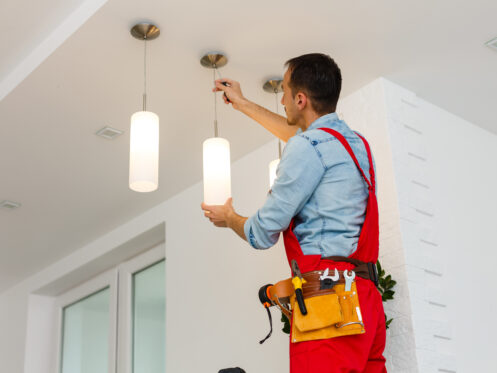From residential to commercial use, LEDs have revolutionized the lighting marketplace for many reasons, most notably their ability to reduce energy consumption. The U.S. Department of Energy has estimated that by 2030, up to 190 terawatt hours of electricity can be saved every year by using LED lighting. Along with a reduced environmental imprint, this translates to an impressive $15 billion annually.
LED lighting systems have become popular for both homes and businesses, from hospitals to entertainment venues. At home, they are used in LED strip lighting underneath kitchen cabinets for task lighting, safer holiday lights, and more. They provide energy and efficiency for corporate spaces, accent lighting in museums, mood lighting in theatres, and economical lighting for any venue that needs to be well-lit for safety.
What is LED Lighting?
To appreciate the benefits of LED lighting, it helps to understand what it is. LED lighting technology creates light by using light-emitting diodes (LEDs.) When electricity flows through these LEDs, semiconductors produce visible light. Energy is released in light particles in the form of photons and heat. The process is called electroluminescence.
First used in labs and testing equipment, early LEDs were expensive and impractical. After they were further developed and refined, LEDs became more affordable. Today, homes and businesses are using LEDs to upgrade their lighting systems and enjoying the following benefits.
Energy efficiency
Businesses will use about half the electricity when using LED instead of fluorescent, incandescent, and halogen light system options. The result is substantial savings, especially in commercial use for businesses that leave the lights on for extended periods. The savings mean extra profits for businesses.
Traditional bulbs emit both light and heat in all directions. Conversely, LEDs point light in a specific direction. And because they are mounted flat, light is emitted hemispherically instead of spherically. Directional lighting means less wasted light and energy.
Longer Life Span
A significant benefit for homes and businesses is that LED light bulbs burn out much less quickly than conventional ones. They will last 30 times longer than incandescent and up to five times longer than CFLs. Depending on usage, the difference is a matter of years before having to replace LEDS as opposed to other types. Instead of burning out, LEDs simply grow dimmer over time.
Specifically, you can expect good-quality LEDs to last 30,000 to 50,000 hours, depending on the type of lamp or light fixture used. Comparably, CFLs last 8,000 to 10,000 hours, while incandescent last only 1,000 hours.
More Environmentally Friendly
Homes and businesses that want to reduce their carbon footprint often use LED lighting systems. They can help companies comply with governmental regulations and attract customers who want to “go green” and show an interest in sustainability.
Both homes and businesses can reduce energy costs by switching to LED light systems. LEDs produce an average of only 11 lumens per watt. Because of that, many countries strive to achieve zero emissions using strategies like phasing out other light systems in favor of LEDs.
Low UV and Heat Emissions
Compared to other lighting, LEDs emit almost no heat. Most of their energy is visible light in the infrared spectrum and very little in the ultraviolet spectrum. Since they don’t have UV rays, LEDs are good for illuminating delicate items like artwork in a museum or homes with expensive art collections and other valuables they want to highlight. The chance of damage to these items is greatly reduced.
In comparison, incandescent bulbs release a whopping 90 percent of their energy as heat. CFLs release 80 percent of energy as heat. Not wasting electricity via heat is part of why LEDs are so much more energy efficient.
Better Safety
LED lighting is safer for the environment, the planet, and people. That’s because conventional sources such as fluorescent and mercury vapor lights have mercury inside the bulbs. After these lights have burned out, they must be handled carefully to avoid releasing mercury. Mercury is known to be toxic to humans and the environment.
Instead of mercury, LEDs use semiconductors to produce light. This eliminates any worries about disposing of bulbs safely.
Durability
Since LEDs don’t have glass enclosures or contain filaments, they resist impacts and vibrations. Incandescent and CFLs are contained in a quartz or glass exterior. In contrast, LEDs, rather than using glass, are affixed to a circuit board and connected with soldered leads. This makes LEDs more resistant to breakage. A direct impact won’t affect them any more than small electronic devices such as mobile phones.
Flexibility in Design
About the size of pepper flakes, tiny LEDs can be used in many ways. This flexibility in design makes them popular in several applications. They can be used in almost any setting, from small devices to lighting huge sports arenas.
Provides Directional Lighting
Conventional light sources give off light at 360 degrees around the bulb. Every direction surrounding the bulb gets equal lighting. Venues that want to light up a specific area with direct lighting, such as a stage, must use reflectors and other devices to redirect lighting from CFL or incandescent bulbs. LED lights eliminate the need to add reflective devices to your lighting system. Therefore, facilities save the cost of adding accessories.
In homes and offices, LED under-cabinet lighting is perfect for tasks such as cooking and reading. LED lighting systems are also popular for use in recessed downlights in hallways, bathrooms, and commercial spaces.
Withstands Frequent Turning On and Off
Lighting systems such as metal halide and fluorescent lights need a warm-up time of a few seconds before fully turning on. Although it’s a slight delay, this will cause the light source to degenerate over time, especially if the lights are switched on and off frequently.
Since LEDs turn on and off instantly, they’re a better choice for businesses that want the lights to come on immediately after a power surge or for doors that are opened frequently. They’re also a better choice for light systems that change colors or for flashing light displays.
Dimming Capability
Venues wanting to dim their lights to create a mood or conserve energy during the day will appreciate LED lighting. Dimming the lights doesn’t negatively affect their efficiency as it does with light sources like metal halide. Some of the traditional light systems are either inefficient when dimmed or don’t dim at all.
Can Operate on Low Voltage
In some situations, businesses may benefit from using lighting systems that operate on low voltage. For example, the business may be located in a place that could become easily flooded. A low-voltage LED lighting system will help protect customers and employees from dangerous electric shocks if the building becomes flooded. Low voltage also makes LED lights safe for outdoor use where other types aren’t up to code.
At Norman Air, we offer electric services, including electrical wiring, panel upgrades, outlet or ceiling fan installation, and more. Also, check out our heating, cooling, and plumbing services. For more information on the benefits and uses of LED lighting systems, call the professionals at Norman Air in Norman.

